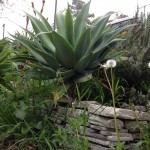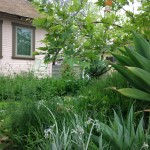We pulled them out. The unwanted weeds. Brought by wind and in free city mulch. From who knows were. They took up residence in the pavement cracks and the bare dirt, and the gravel. We deemed them undesirable. Despite their wild beauty. Despite their many (medicinal and edible and material) uses. Germinated by winter rains and early warmth, they threatened to overtake the flowers and succulents that we planted there before. We weeded for days. We tried to uproot them before they set seed, lest they reproduce. And smother the more delicate plants we intentioned.
The weeds were beautiful. Wildflowers. Was it their foreign ancestry that made them unwelcome? Their ability to adapt? Their unruly character? Or our lack of understanding them? Would becoming familiar with their uses let us appreciate them? Love them like we did as children holding them to our chins, making wishes on their floating seeds, chewing on their sour stems?
I ask out of desperation. Because my garden has become more weeds than selected species. And I am tired of weeding. But also because I cannot look at its weediness without thinking of my children: gangly and beautiful and wild. And not just my children but all of those somewhat prickly teenagers floating out into the world to find themselves and root themselves much like the weeds we pull and the weed they smoke. In fact, hemp (Cannabis sativa) was a major U.S. fiber crop from colonial days until after World War II, when cheap synthetic fiber killed demand for it.
We don’t welcome teens into our everyday urban lives. Our sidewalk seating is reserved for paying customers. Our plaza steps and walls are designed to reject skateboards. Our new parks with tot lots, welcome children aged 5-12. Our high schools are fenced and locked to try to keep them in. This only makes them want to escape. They have the skate parks in the corners of some of our parks. And their friends’ basements or the converted garage. Or fast food joints. Or in our neighborhood, the amphitheater behind Yosemite Park where drug deals go down. No wonder they become reclusive … they feel unwanted and anxious.
Teenagers are forgotten, or purposely excluded, in planning and design. A New York Times article called out how suburban design was failing teens nearly two decades ago, in the Columbine aftermath. A more recent academic article describes in detail the benefits for all when teenagers participate in the urban and community design process. Today’s teenagers are tomorrow’s environmental stewards and decision-makers. How we include them and plan for them will make a difference in how they approach the problems they inherit. How we treat them today will shape how they treat us tomorrow.
California’s Institute for Local Government wrote a white paper on the who, what, why, where, and how of engaging young people in the planning process. And because I can’t let go of the parallel between teens and weed(s), check out this NPR story on foraging for edible weeds in the urban landscape.
Let’s cherish these wild, wind-blown weeds and teens. Let’s listen to them and plan for them and with them. Let’s learn from them about determination and resilience. As the future gets tougher and hotter and wetter or dryer (depending on where you live), we’re going to need both.


